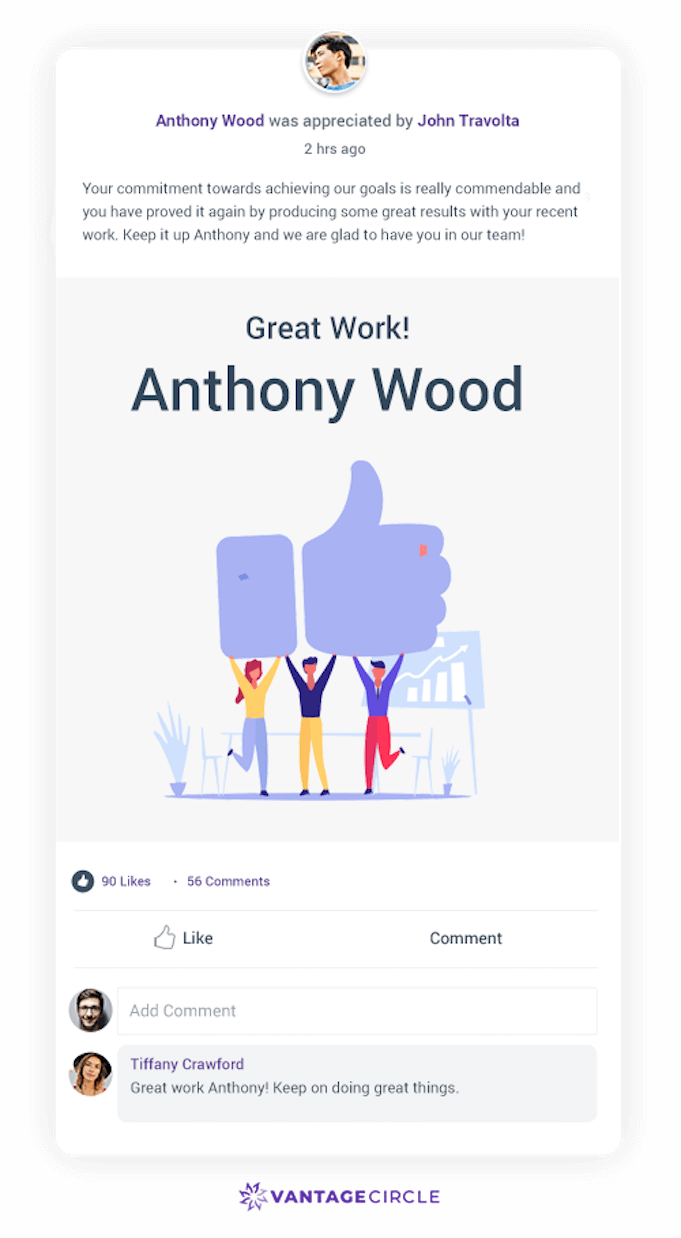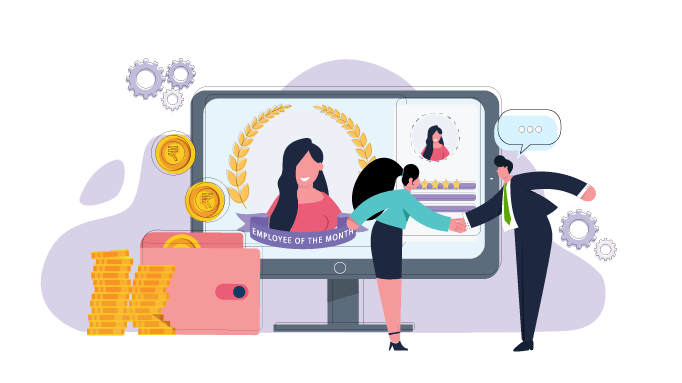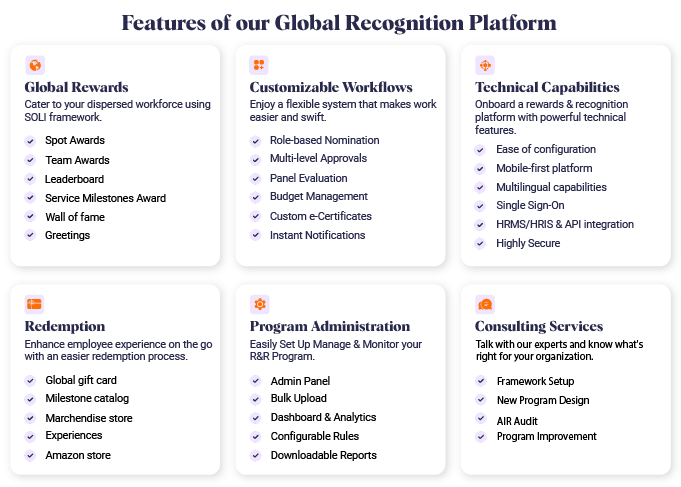Social Recognition Basics: A Quick Guide
Social recognition boosts engagement by 3.7 times and reduces the likelihood of seeking a new job by 55%.
A decade ago, social recognition wasn't a topic that HR experts were talking about. But, as workplaces started embracing employee recognition, its social aspect, too, entered the scene.
So, social recognition has gained significant traction in recent years.
In this blog, we go over the fundamentals of social recognition. We will start with its meaning and importance and check out some social recognition types with examples.
We wrap this blog up with interesting tips for implementing a successful social recognition program.
And if you are seeking quick answers or solutions to common questions about social recognition, you can jump into our FAQ section as well!
Key Takeaways
- Meaning of social recognition
- Examples of some popular and well-known social recognition platforms
- Top benefits of social recognition and why does it matter?
- Best Practices for Social Recognition
- Some famous organizations that provide social recognition programs
What Is Social Recognition?
Social recognition involves acknowledging and rewarding employees in a social manner, such as expressing gratitude in team meetings, featuring them in newsletters, or providing digital badges. In modern workplaces, it can be challenging to maintain such recognition, especially for remote teams. Utilizing digital platforms can create a common forum for social recognition in such environments.
Now let’s explore the different effective examples of social recognition that can be implemented in any organization to create a thriving and inclusive work environment.
Example Of Some Popular And Well-Known Social Recognition Platform In The Workplace
1. Newsletters
A wonderful method to promote good work is to mention their names in a monthly/weekly newsletter.
2. Notice boards
Notice boards are one of the oldest ways to make a public announcement.
A well-designed, engaging notice board can entice people to stop walking, glance away from their phones, and absorb relevant messages. The only catch is that your board ideas must be very good.
3. Social intranet platform
A social intranet serves the same functions as social media apps in the workplace. It is a platform for internal communication and cooperation that allows employees to interact and create relationships. A social intranet promotes information exchange, interactions among colleagues, and collaboration around common goals.
4. Company’s social media pages
Your company's social media pages are great for sharing messages with a bigger crowd. The most effective social media for businesses include Facebook, Instagram, Twitter, and YouTube.
5. A Digital Social recognition software
Digital social recognition involves a common platform where employees may see who was recognized by whom and why.
Being digital, it allows recognition to be instant and spontaneous.
It serves as a place where employees can gather and share their workplace experiences. Also, it allows for subsequent reactions from them. Like, say, congratulating each other in the comments section.
Social recognition can extend beyond professional achievements. It can also celebrate employees' personal milestones and life events. For example, employees getting married, having a kid, or celebrating a birthday.
Such personal touch can create genuine connections with one another. It leads to increased engagement and, as a result, higher productivity at work.
Platforms like Vantage Circle can help immensely in this regard. It enables peer-to-peer recognition, boosts employee engagement, and offers instant rewards.
The platform includes the following features that are highly suitable for social recognition:
A. Single sign-on (SSO) and seamless HRMS and chat applications interfaces.
B. You can interact with the recognition posts by liking, commenting, and sharing.
C. It is a points-based rewards system that allows choosing between monetary or non-monetary awards.
Read our blog on: Points Based Rewards System: A Complete Guide For HRs
Here's an example of social recognition from Vantage Circle's employee recognition solution.
It's a recognition feed where employees can see, like, and comment on previous recognitions.

Picture courtesy: Employee appreciation post via Vantage Circle's Employee Rewards and Recognition Platform
D. It’s easy-to-use mobile version making recognitions immediate and hassle-free.
E. The gamified features like leaderboards and badges encourage friendly peer competition.
F. Vantage Pulse helps managers create custom surveys. It takes employee feedback and gains insights into employee performance. It uses analytics for the same.
Check out our client success stories to learn how our rewards and recognition solution assists them with their job.
Moving on, let's explore the importance of social recognition and the benefits it brings.
Importance of Social Recognition And Why Does It Matter?

1. Boosts employee engagement
Many employees, particularly those working from home, may feel their efforts go unnoticed. Naturally, this can lead to a drop in engagement and, as a result, a drop in staff retention.
A social recognition program that allows all employees to instantly see, support, and remark on their peers' achievements can enhance engagement and job happiness.
2. Reduce costs and improve ROI
replacing an employee can cost between 50% and 150% of their salary? This cost can skyrocket to up to 213% of their salary for specialized, senior, and executive roles!
Let’s look at an interesting case study here.
JetBlue's Recognition Makeover:
JetBlue teamed up with Globoforce to create a cool social recognition program. Employees nominate peers for everyday wins, shared company-wide. The unique twist? Recipients get points they can spend on dinners or save for vacations.
Why was it a hit?
- Personal Power: Recipients choose how to use their rewards.
- Internal Buzz: Recognition stories spread within the company, creating positive role models.
- Peer Cheers, Not Reviews: Feels more like a thank-you than a formal review.
- Smart Recognition: Instead of predictable pay raises, on-the-spot bonuses keep things fresh.
And the numbers spoke for themselves: A 10% rise in recognitions, Jetblue saw 3% more staff stick around happily, and engagement jumped by 2%!
Thus, happy, recognized employees are like keepers. It's a small investment in saying 'great job' that pays off big by retaining good people. This means less spending on hiring and training. It is indeed a smart move for the company's pocket and team spirit.
3. Fosters your organizational values and overall positivity
Social recognition can also help organizations showcase their values and positive culture.
Recognizing the success of a campaign, for example, promotes the qualities of innovation and dedication. Likewise, celebrating a personal event, such as a birthday, adds to a good, inclusive, and human workplace.
3. Increased retention and decreased absence of staff
Since the beginning of this blog, we have been saying appreciation makes employees happy. And happy employees will stick around as they enjoy coming to work.
A Gallup survey says organizations with engaged teams see 81% lower absenteeism. They even take lesser sick leaves compared to workplaces that don't appreciate them.
4. Positive impact on customers
Studies have found that companies with high employee engagement scores had twice the customer loyalty (repeat purchases, recommendations to friends) than companies with average employee engagement levels.- Hay Group.
The beauty of social recognition is that it's benefits go beyond internal-only recognition. It also opens the door to receiving external recognition from customers, clients, or even vendors.
How?
The key to customer happiness is to prioritize employee happiness. They also attract new clientele by providing exceptional experiences. It's simple: happy employees lead to happy customers.
5. Works wonder in employer branding
When you work in human resources, you understand how important it is to attract and keep great talent. And for that, you must be able to differentiate your brand from its competitors.
According to Gallup's study:
Social recognition contributes to a friendly and upbeat environment.Such environments foster a positive culture with employer loyalty and a good retention rate. The same benefits extend beyond income and benefits, attracting prospective employees.
4. Uncover the silent heroes
Every organization has some "Silent Superstars" at the entry level. They are the ones who create wonderful results but stay under the radar of usual employee recognition.
However, people who receive enough recognition will only stay in entry-level positions for a short time.
Recognition takes them forward, proving their readiness to take on bigger responsibilities. They gain their peers' and seniors' trust and respect in a very short period.
So now, how to unveil the silent superstars and regain their trust in your work system? Of-course, you require a suitable internal communication platform. But additionally, an effective employee survey tool is essential to get you a high participation rate.
It should facilitate feedback from managers and peers beyond the immediate team through anonymous surveys. In short, it must empower leaders to recognize and support hidden contributors missed by traditional recognition systems.
Would you like to schedule a demo to enhance your employee survey process?
Profound impact on leadership
What gets recognized gets repeated.
- Profound impact on leadership
As a leader, your recognition holds tremendous value.
First of all, acknowledging and appreciating your team's efforts through social recognition contributes to a positive leadership image. It is because leaders who consistently acknowledge and value their team's efforts cultivate respect, trust, and admiration.
Further, it shapes a culture characterized by approachability, empathy, and genuine concern for employee well-being. All of these factors help shape a positive perception of their leadership.
In today's dynamic workplace, effective leadership goes beyond authority—it requires vulnerability, active listening, and genuine interest in your team's development. Demonstrate your support by recognizing achievements and valuing feedback to create a thriving environment where everyone can succeed. Consider seeking professional coaching to refine your skills in giving praise and delivering constructive criticism, empowering you to become an advocate for your team's growth and success. Embrace these qualities, and watch your leadership style transform for the better!
Now, let’s understand the top best practices for social recognition which are crucial for maximizing its effectiveness.
The Top Best Practices For Social Recognition?
1. Make it instant and frequent.
Strike while the iron is hot. And push your employees to strive to perform their best continually.
Don't wait. If an employee does an outstanding job or goes above and above, recognize them immediately.
More than 90% of employees say that when they are recognized for work, they are more inclined to repeat it.
Social recognition is only effective when employees recognize one another voluntarily. “Predetermined award timing is a common employee recognition problem,” says SHRM.
2. Make it engaging.
Look for ways to customize your recognitions with humorous gifs/ photographs, like, and comments section. A point-based rewards system is another fantastic way to make showing appreciation appealing.
3. Invest in a recognition software

Take time to appreciate employees, and they will reciprocate in a thousand ways.- Dr. Bob Nelson
If you're considering moving recognition online or starting your employee recognition effort from scratch, you must invest in employee recognition software.
Apart from being engaging, it has the following benefits:
Recognition software allows managers to evaluate the effectiveness of the initiative better. They know what is working for their employees, and it's the potential return on investment.
Recognition software ensures that every employee, regardless of location or organization level, can get the same recognition experience.
When implementing an employee recognition program, HR can expect minimal headaches. It comes with less admin work after it's set up, integrated with existing systems, and launched.
Digital platforms like Vantage Circle replace the archaic concept of a once-a-year employee appreciation ritual. With Vantage Rewards, well-deserving VCian receive immediate appreciation for work well done by their managers and teammates.

Book a personalized demo with us for your unique employee spotlight needs!
4. Make it inclusive.
Everyone should be able to engage in your social recognition program. It must encompass everyone from entry-level workers to leaders.
5. Showcase top leadership's support.
The support of senior management is critical to the success of any social recognition initiatives.
Employees regard senior management as credible. As a result, if senior leadership encourages them to do so, they are more inclined to recognize each other.
Some Famous Social Recognition Programs
Here are some popular and well-known social recognition platforms used for employee recognition and engagement in the workplace:
1. Vantage Circle: As discussed above, Vantage Circle is an employee recognition platform that offers a comprehensive suite of tools to celebrate achievements, reward employees, and enhance engagement through personalized rewards, social recognition, and employee benefits.
2. Kudos: Kudos is a user-friendly employee recognition platform that fosters a positive workplace culture by enabling employees to give and receive meaningful recognition, track achievements, and build a sense of appreciation and camaraderie within the organization.
3. Bonusly: With a focus on peer-to-peer recognition, Bonusly allows employees to give and receive micro-bonuses as a form of appreciation, fostering a culture of continuous recognition and encouraging positive behaviors.
4. Fond: Fond provides an intuitive platform for recognizing and rewarding employees, offering access to various perks and rewards to boost employee morale and maintain a motivated workforce.
5. Terryberry: Terryberry's employee recognition solutions encompass various tools like awards programs, social recognition, and performance-based rewards, facilitating organizations to build a culture of recognition and improve employee retention.
6. Awardco: Awardco is an all-in-one platform that empowers companies to recognize their employees' accomplishments with a diverse range of rewards and customizable recognition programs.
7. Motivosity: Motivosity emphasizes peer-to-peer recognition and regular feedback through its employee engagement platform, fostering a culture of appreciation, teamwork, and transparent communication.
8. Reward Gateway: Reward Gateway is an employee engagement platform that offers social recognition features alongside employee benefits, discounts, and well-being programs, enhancing overall employee satisfaction and motivation.
9. O.C. Tanner: O.C. Tanner specializes in creating customized recognition solutions, enabling companies to celebrate achievements, appreciate milestones, and strengthen employee engagement through meaningful rewards.
10. Achievers: Achievers provides a robust employee recognition platform that promotes continuous appreciation, aligns with company values, and encourages positive behaviors for enhanced employee engagement and productivity.
Frequently Asked Questions About Social Recognition
1. What is social recognition in the workplace?
A. Social recognition in the workplace refers to the practice of acknowledging and appreciating employees' achievements and contributions publicly within the organization, fostering a culture of appreciation and camaraderie.
2. What is an example of social recognition?
An example of social recognition is when a team leader publicly praises an employee's outstanding performance during a team meeting, highlighting their efforts and impact on the project's success.
3. What is the power of social recognition?
A. The power of social recognition lies in its ability to boost employee morale, strengthen interpersonal connections, and improve overall employee engagement, leading to increased productivity and a positive work environment.
4. What is the effect of social recognition?
A. Social recognition positively affects employee motivation and job satisfaction, leading to higher retention rates, improved teamwork, and a sense of belonging, ultimately driving organizational success and employee loyalty.




















